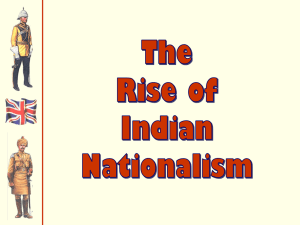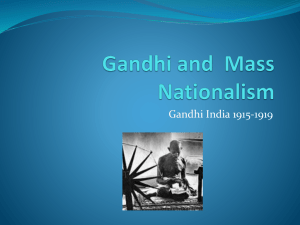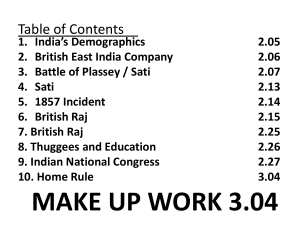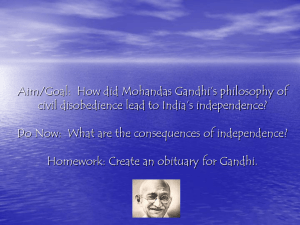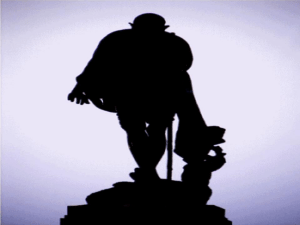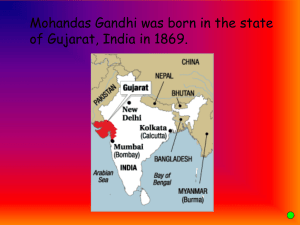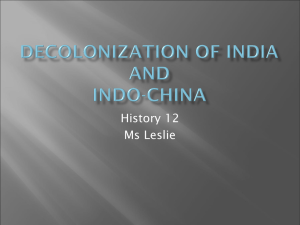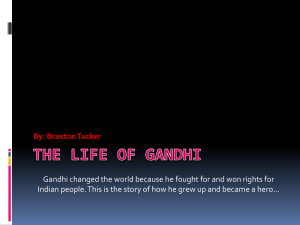The power of Gandhi - Start your own free website
advertisement
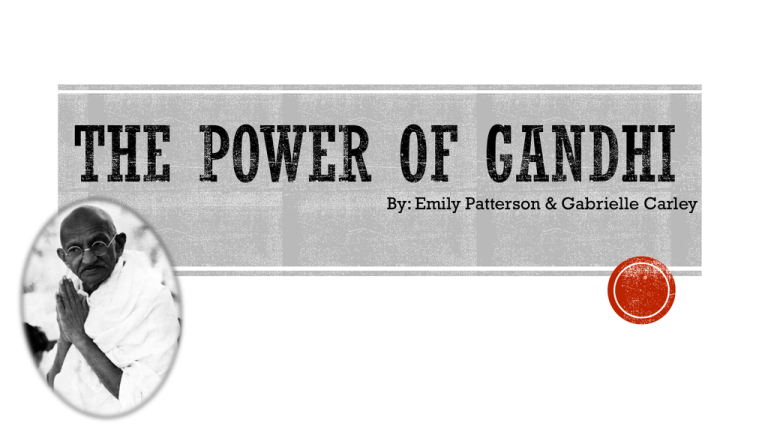
By: Emily Patterson & Gabrielle Carley “ “ I object to violence because when it appears to do good, the good is only temporary; the evil it does is permanent. -Mahatma Gandhi http://www.brainyquote.com/quotes/authors/m/mahat ma_gandhi.html This quote said by Gandhi shows his role as a transformational leader by putting his words into action. By sharing his vision of peace, Gandhi gained followers that helped him to put non-violent protests into action. Even though he was looked upon as superior to the rest, he acted as if he were not; he acted as one with India. A change in order with commitment to vision. 1. Challenge the process: Discover something that needs to be changed. 2.Inspire a shared vision: Gaining followers and showing them why change must be made. 3.Enable others to act: Telling followers what they must do to inspire change. 4.Model the way: Show that change can be accomplished by putting it into action Idealized Influence: Trust, admiration, loyalty, and respect amongst followers. Inspirational Motivation: Inspires followers towards the new ideas or goals into a positive future. Intellectual Stimulation: Raise their followers awareness regarding problems and develop their ability to solve problems in many ways. Individualized Consideration: Considers each individual as their own. This presentation will explain how Gandhi used transformational leadership to achieve his goal: India’s independence and the end of civil war. While in Africa and on his trip to India, Gandhi noticed that the British were treating the Indian people as if they were a minority. The British overtook India’s independence and tortured them like they had the status of a slave. “WE’RE ALL GODS CHILDREN.” “We deserve equal treatment.” -Gandhi South Africa and India were part of the British empire, therefore, Gandhi thought the people living there shouldn’t have been set aside. To protest this, Gandhi started off by getting a small group of followers to begin burning their passes that only non-whites, like themselves, had to carry. Gandhi motivated others to start building Indian communities to help bring the Indian people together. Together, the people organized a newspaper to spread awareness around the world of the problems they were facing with the British Empire. Gandhi was a role model to the Indians because he used nonviolence against the British by accepting a beating and taking the consequences of getting arrested. Gandhi was willing to sacrifice his own happiness to help the cause. Instead of giving in to the British rules, such as taxes on salt, Gandhi led his followers to rise up against them and march to the Indian sea to produce their own salt. Along with this action, Gandhi inspired the Indians to stop buying clothes from the British and begin making their own. INDIA’S INDEPENDENCE Challenge the Process: Hindu’s and Muslims began to dispute over land and their differences in beliefs. Inspire a Shared Vision: To inspire non-violence, Gandhi states that he is “a Christian, Muslim, Hindu, and a Jew.” By saying this he resembled the idea of equality. Enable Others to Act: To prevent the country from splitting into two, Gandhi offers Jinnah prime minister ship. Model the Way: To stop the fighting, Gandhi commits to fast until death if needed. “ You’re killing Gandhi, do what is right.” Transformational Leadership: A change in order with commitment to vision. By challenging the process, inspiring a shared vision, enabling others to act, and modeling the way, transformational leaders can make change within the problems that they face. Characteristics of a Transformational Leader: Idealized Influence Inspirational Motivation Intellectual Stimulation Individualized Consideration Through the steps of transformational leadership, Gandhi faced the challenges of racism within the British empire to help bring India independence. Although he didn’t stop the disputes between the Muslims and Hindu’s, he managed to raise awareness that violence never helps, you can only achieve change through peace. “ We are all God’s children.” -Gandhi
